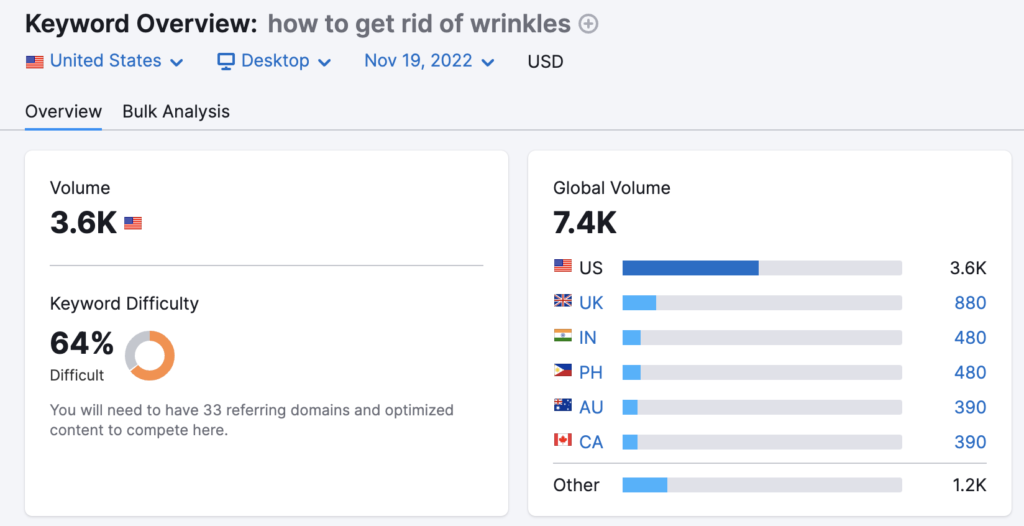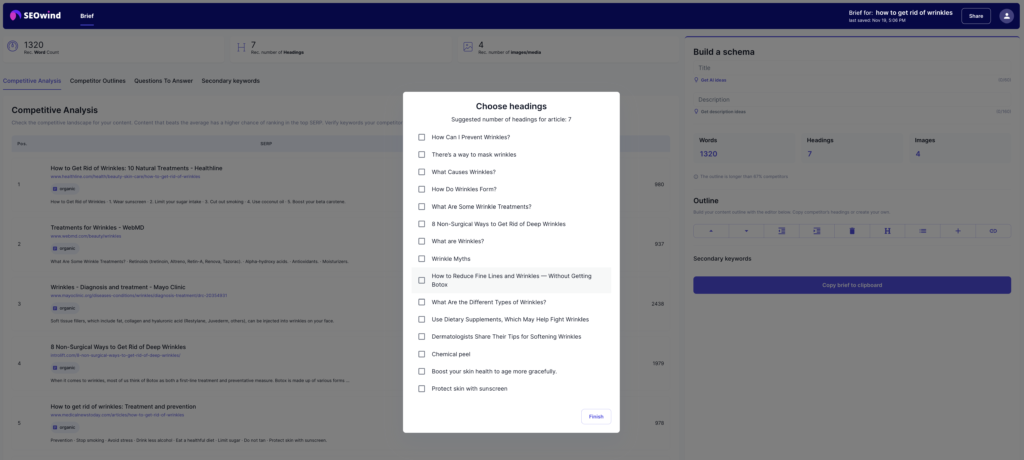This question could be answered by writing a whole book or even several. Therefore, I will try to talk briefly about the essential elements. Firstly, a good writer writes in such a way that his texts meet the demand generated by search engine users. These users are often looking for answers to their problems. Therefore, it may be better to write about “how to get rid of wrinkles” than “15 ways your grandmother didn’t know about that help you get rid of wrinkles”.

The first phrase has a volume of searches. Therefore, the second is not necessary.
- Where to get topics and keywords from. You can export the former from Buzzsumo. This tool shows the more catchy articles of the past based on social media signals (number of shares).
- On the other hand, keywords can be found in tools such as SEMRush. You can check the number of searches, how complicated the phrase is (how competitive) and many other valuable pieces of information there.
It is also important to remember that when it comes to SEO, your content should be original and not contain too many repetitions of the same keyword or phrase. Quotes are ok, but if your article consists mainly of sections, then don’t expect to start appearing high in search results.
To become a better writer, Every article should be well structured and contain useful, sought-after information to satisfy visitors’ needs. However, keywords should also be used tactfully so that the text does not look like it is being written for Google’s robot.
Good structure (headings and sub-headings) helps search engines understand your site better and rank it higher. But don’t overdo it. These elements are like a condiment and not the main course. The main course is your article.
Finally, remember that SEO is a long-term process and requires ongoing work on content and optimisation processes. Hence, the fact that you are writing, or have written content, is just the beginning of the long journey.
Another thing is the way you write. To appear high in search engines, avoid creating a wall of text. Instead, use 2-3 sentences per paragraph. That reads much better.
On the other hand, avoid creating yet another article that superficially treats a problem. I call such articles “indirect duplicate content”. This content is supposedly not a copy of existing reports but doesn’t contribute anything new. So, for example, perhaps writing three paragraphs about “how to avoid sunburn” will not contribute anything to the topic. Describing a problem like a sunburn arises, focusing on causes and effects, however, may already be something more sophisticated, although it still answers the question that potential site visitors are searching for.
Creating content for SEO is a complex process that combines the ability to write exciting and original text with keyword research, as well as knowing what structure and layout work best. However, if you stick to a few basic principles, understanding the basics of creating SEO-optimised content is not difficult.
Another thing is headers. Create a specific post architecture. The best way to do this is with a tool. E.g. SEOWind.io allows you to track the sub-page structure of your competitors. How many headers do your competitors have on average, and how heavily are nested?
Also, how many illustrations are in the text, and how are the URLs, Title Tags, Meta Descriptions, and H1 structured?
Stick to the rule that the title tag should start with a keyword and be 50-60 characters long, and the meta description should not exceed 150. In addition, the URL should be simple, and where there are spaces, there should be hyphens and contain the keyword. Finally, the H1 – should be slightly different from the title tag, and naturally, the keyword or a variant of it should be included here too.

In the next step, consider what else you can add to the page to avoid the wall of text. Let me mention some solutions:
- Quizzes with several questions
- A video that expands on the topic (you can use a video that is not necessarily your own… embed it from YouTube)
- Was this article helpful (YES / NO) – ask users
- Use an AI widget for voiceover, i.e. reading the content of the article
- Think about the Table of Content, i.e. links that allow you to jump between paragraphs
- If you have interesting data, include it (embed it) as a Data Studio.
- Add engaging visuals – photos, infographics, illustrations, quotes and more
- Think about adding additional social media sharing options
- Link to other relevant articles (internal linking) or even external sources (external linking)
- Once all this is in place, publish the essay on your website.
- To speed up its indexation, you may be tempted to submit the article to the search console.
You now have to wait a few weeks. After that, the article will be indexed, sit in the SERPs and start collecting data in the search console on which keywords are participating in the traffic. This is valuable knowledge for further optimisation and expanding the article with more sections.
But that’s a topic for another blog post…
I hope I’ve helped at least a little. And if you have any questions, just let me know via email.
 Published in: November 2022
Published in: November 2022
Last Updated in 2022-12-28T21:41:33+00:00 by Lukasz Zelezny



